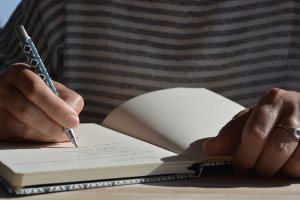Reflections—and Lessons Learned—From Remote Learning
Experiences during remote learning inspire a teacher to reconsider—and refresh—her curriculum for the fall.
Your content has been saved!
Go to My Saved Content.Our last day of the school year, three months and a week after we went virtual, brought a strange sadness. After the whirlwind and stress of the last few months, the end felt like a slow exhale instead of a bang—or, as a student said, one of those balloons that float to the ceiling outside your grasp and then slowly deflate on their own. At the end of class, we waved goodbye and said, “Thanks,” and then one by one, my high school students clicked off, leaving me staring at my own face on the screen.
Things moved so quickly since mid-March that it’s been hard to stop and let everything sink in. When I got the results of my first Covid test back negative, it was a poignant reminder that other people in my community—people I know—have not been as lucky. Some have died. As I write this, for the first quiet moment in a while, I have time to feel deeply sad for them.
I imagine it will take a while for teachers, staff, and students to have enough quiet moments to come to terms with all we have experienced (if we ever do), as Covid-19 spikes and virtual learning stretches on. But at the same time, many of us have also found new ways to be flexible, connect, and grapple with the world around us that we might have avoided or skipped over before. Some of these changes or insights I hope to take with me into this coming school year, whatever that may look like.
Creating Time for Civic Engagement
While we were learning from home, we were also alert to events outside our school that prompted students and teachers to engage in a deeper way than the previous flow of the school day provided. The large (masked) gatherings to protest the death of George Floyd and centuries of institutionalized racism were the first time many of us left our homes in New Jersey.
While students and teachers discuss race and equity openly at school, having regular discussions for the entire school had been challenging before, due to our bell schedule, which has no common lunches, along with students’ extracurricular commitments to clubs and teams. Now, we all had time, and our school’s Diversity Alliance club (of which I am a co-advisor) held three open discussions, initiated and led by students. Many students started their own online fundraisers for Covid-19 first responders, and others launched online actions to support Black Lives Matter.
After these experiences, I’m left wondering in what ways the “normal” school day prevents civic engagement and deeper contemplation that help students connect school learning with real life rather than conduct simulations of it in model congresses.
Raising Self-Awareness
A project unique to this time was a “Covid Journal,” in which students tracked the news and their responses to it in an electronic or paper journal. About a month into the project, students asked if they could stop responding to the news and just write, and their entries became more personal.
Reflecting on their journals at the end of the trimester, students said that they noticed a shift in themselves from the initial shock and uncertainty to feelings of resignation or acceptance of their quarantined lives. As the months passed, their journals also became less tethered to the outside world and showed that time had taken on an elastic quality, stretching endlessly in some days or hours, contracting quickly in others. By the end of the project, many noted how their mental well-being coincided with their attention to breaking news, which seemed like a lesson they would take with them.

In recent years, journaling and writing about feelings as a classroom writing strategy has fallen out of favor in the schools I’ve taught in, with focus instead on close reading of challenging texts. But journaling coupled with reflection—especially during times of historic crisis—showed me that this activity can support complexity and has a long tradition for good reason. I plan to continue it next year.
Refresh Your Teaching
After debate among our staff about the merits of synchronous versus asynchronous instruction, I turned the question to my classes in a Google Form, asking about what they preferred. They said they liked synchronous online nonvideo instruction, such as simultaneously chatting and answering broad questions in small-group Google Docs, but were most engaged during video discussions. I ended up balancing both of these every week.
Teaching remotely also made me look at my own content with fresh eyes. After contemplating whether or not to read One Flew Over the Cuckoo's Nest with my freshmen this year, I decided to stick with the book and instead change how I taught it. I recorded myself giving a mini-lesson focused on sexism in the 1950s and 1960s, used ads and photos from the time as visuals, and then foregrounded the problems in a way that students could linger with and use later in short papers. I also paired the text with a chapter from Tommy Orange’s There There.
Amid the push for student-driven learning in past years, I have shied away from the stand-and-deliver lecture, but the success of my 15-minute lesson made me realize that more traditional teaching styles still have merit. A few students cited teacher mini-lectures as a driver of learning this year, and There There became a favorite text for a handful. The experience reminded me to reevaluate assumptions to uncover better approaches and to give students the opportunity to weigh in on how they prefer to learn.
Deliberate Connections
In the classroom, I tend to be less of an emotive hugs-and-high-fives teacher and more of a let’s-get-to-work-now kind of teacher. Yet teaching remotely provided a new opportunity to focus on how to carve out time for social and emotional activities with each class in the absence of face-to-face connections. Early on, my students took attendance online by rating their mood, and when our district started allowing us to use video classes, I also checked in by sharing online puzzles to start class or putting students in Zoom breakout rooms with several classmates at random.
Unpredictably, the structure of virtual school gave us more time to talk about connections in our lives and the structures that shape them, which created new affinities among us. Before the final week of school, I met my departing homeroom of seniors over Zoom, and we talked about their plans, their favorite shows, their jobs. My son joined briefly to talk about a recent Avator obsession; our class felt almost like a family. As we move into what is likely a hybrid learning model this fall and can’t check in as easily by noticing a facial expression or posture, I realize that the success of learning depends on consciously building in opportunities for connection, particularly when showing up is literally rolling out of bed and clicking a post.
Whether we are in physical, virtual, or hybrid classes this fall, I plan to be intentionally connecting with students and to the world even more. We have all been through (at least) two major historical ruptures together: a pandemic and a reckoning on racial inequality. To talk about one without the other implies that they are unrelated. But both the racial disparities in Covid-19 deaths and the protests and rallies for racial justice reveal that access to basic privileges—to be healthy, to live—remains unequal. Students realize this, and schools can support young people to go into the world with greater understanding of structures that shape us, not keep them from it.
